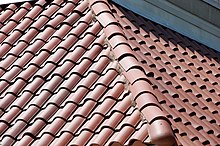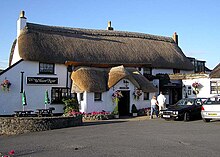Medieval buildings, just like modern buildings, needed roofs. Medieval people didn't have asphalt shingles or roll roofing or roofing tar, but they still had plenty of options.

Near the Mediterranean, the most common roof was clay tiles, as seen above in a modern building. This is the kind of roofing the Romans had used, and indeed which is still found in southern Europe and in places like San Diego and Texas in the US. Basically clay rectangles were shaped by being curved over someone's thigh, then fired. These curved ceramic tiles were slightly wider at one end than the other (look at the shape of your own thigh and you'll see what I mean), so they could be overlapped on a sloped roof, causing rain to run off. The style for modern roof tiles is the same (though they are no longer shaped over someone's thigh).
Wooden shingles could be used instead of clay tiles, and so could slate tiles (which were rectangular, not curved--you can now buy asphalt roof shingles that are supposed to look like slate). In both cases, getting the overlap right was the key to a watertight roof. A broken slate tile or rooted wooden shingle could be delicately removed and a new replacement worked in. Those are slate roofing tiles you see above.
Wooden shingles then, as now, have the danger of catching fire. Northern cities therefore intermittently tried to get everyone to use slate. A lot of western Europe away from the Mediterranean still uses slate. Alternately, one could make roofing tiles out of lead. These worked just as well as slate, in fact better because it was easier to shape the lead, but lead has the distinct problem that it will melt, which slate won't. A castle under siege could melt some of its roof tiles to pour on the attacking army, which seems like an advantage, but Notre Dame of Paris, whose lead roof had long protected it, had those lead tiles melt and spew toxic lead dust into the surrounding neighborhoods when the church caught fire.
Then there was thatch. A thatched roof had the distinct advantage that it was fairly cheap and lighter than shingles or tiles, requiring less sturdy beams. It was made from reeds or straw, tied together in bundles and fastened to the wooden roof beams. It was very common in the Middle Ages, and it was also used in Inca-era Peru. Houses are still being thatched in parts of England and Ireland (often to give an Olde Tyme look), though thatch is rarer on the Continent. Making a good thatched roof is a skilled trade, but if done right, a thatched roof could last a generation. A thatched British pub is shown below.

Of course with thatch you have to put up with critters building nests in your roof. The biggest danger is fire, because thatch will burn just as readily as a wooden roof. A problem now, thatchers will tell you, is that due to acid rain the reeds are more fragile than they used to be, so a roof won't last as long.
© C. Dale Brittain 2021
For more on medieval buildings, see my new ebook, Positively Medieval: Life and Society in the Middle Ages. Also available in paperback.


